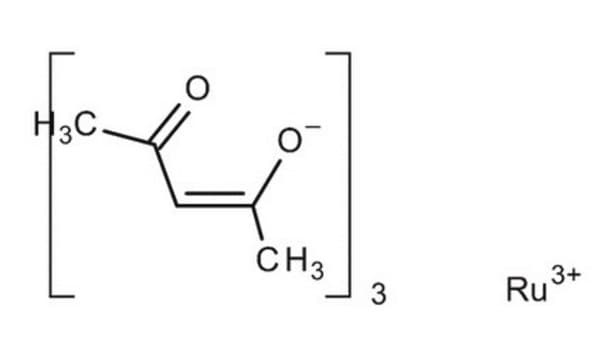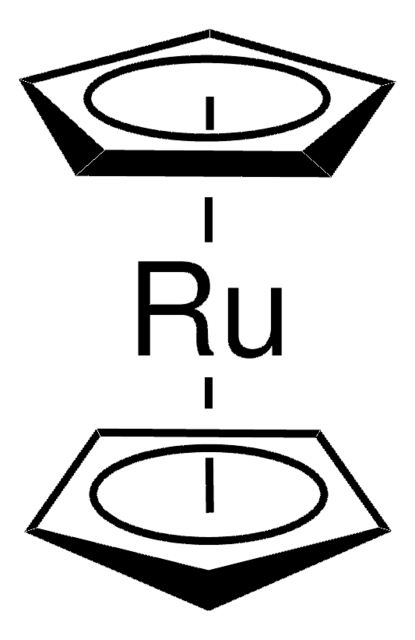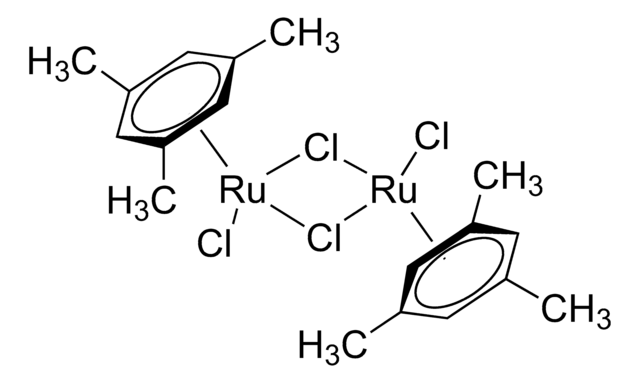所有图片(2)
About This Item
线性分子式:
Ru(C5H7O2)3
CAS号:
分子量:
398.39
EC號碼:
MDL號碼:
分類程式碼代碼:
12352103
PubChem物質ID:
NACRES:
NA.23
推荐产品
化驗
97%
形狀
solid
反應適用性
core: ruthenium
reagent type: catalyst
mp
260 °C (dec.) (lit.)
SMILES 字串
CC(=O)\C=C(\C)O[Ru](O\C(C)=C/C(C)=O)O\C(C)=C/C(C)=O
InChI
1S/3C5H8O2.Ru/c3*1-4(6)3-5(2)7;/h3*3,6H,1-2H3;/q;;;+3/p-3/b3*4-3-;
InChI 密鑰
RTZYCRSRNSTRGC-LNTINUHCSA-K
正在寻找类似产品? 访问 产品对比指南
一般說明
Ruthenium(III) acetylacetonate is a dark violet solid that exhibits high solubility in organic solvents. It exhibits fast kinetics for oxidation and reduction, facilitating efficient electrochemical reactions. It is widely used in the field of nanomaterial synthesis, solar cells, batteries, and supercapacitors.
應用
Ruthenium(III) acetylacetonate can be used:
- As an electrolyte in redox flow batteries. It helps to enhance the voltage efficiency of batteries.
- As a starting material to synthesize homogeneously dispersed Ru nanoparticles for super capacitor applications.
- As a precursor to synthesize ruthenium single atom multifunctional electrocatalyst that exhibits outstanding catalytic performance for zinc-air battery and overall water splitting reaction.
- To fabricate Ru2P anodic catalyst for polymer electrolyte fuel cells. It helps to improve hydrogen oxidation reaction performance.
- As a reliable and stable cathode interfacial layer to significantly improve solar cell efficiency and stability.
儲存類別代碼
11 - Combustible Solids
水污染物質分類(WGK)
WGK 3
閃點(°F)
Not applicable
閃點(°C)
Not applicable
個人防護裝備
dust mask type N95 (US), Eyeshields, Gloves
其他客户在看
Bih-Show Lou et al.
Scientific reports, 6, 19949-19949 (2016-01-29)
The synthesis of highly dispersed and stable ruthenium nanoparticles (RuNPs; ca. 2-3 nm) on porous activated carbons derived from Moringa Oleifera fruit shells (MOC) is reported and were exploited for supercapacitor applications. The Ru/MOC composites so fabricated using the biowaste carbon
Kaipeng Liu et al.
Nature communications, 11(1), 1263-1263 (2020-03-11)
Single-atom catalysts (SACs) have demonstrated superior catalytic performance in numerous heterogeneous reactions. However, producing thermally stable SACs, especially in a simple and scalable way, remains a formidable challenge. Here, we report the synthesis of Ru SACs from commercial RuO2 powders
Tuenissen, H.T. Elsevier, C.J.
Chemical Communications (Cambridge, England), 667-667 (1997)
Yuxiao Zhang et al.
Chemistry, an Asian journal, 14(2), 278-285 (2018-12-07)
Molybdenum disulfide (MoS2 ) has been regarded as a favorable photocatalytic co-catalyst and efficient hydrogen evolution reaction (HER) electrocatalyst alternative to expensive noble-metals catalysts, owing to earth-abundance, proper band gap, high surface area, and fast electron transfer ability. In order
Ming Zhao et al.
ACS nano, 13(6), 7241-7251 (2019-05-31)
Owing to their highly open structure and a large number of low-coordination sites on the surface, noble-metal nanoframes are intriguing for catalytic applications. Here, we demonstrate the rational synthesis of Ru cuboctahedral nanoframes with enhanced catalytic performance toward hydrazine decomposition.
我们的科学家团队拥有各种研究领域经验,包括生命科学、材料科学、化学合成、色谱、分析及许多其他领域.
联系技术服务部门










